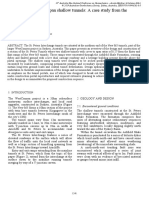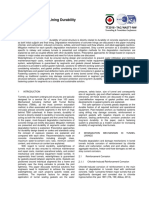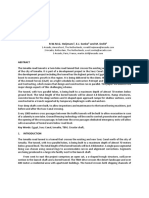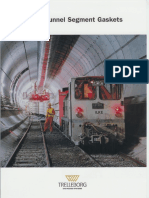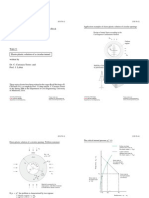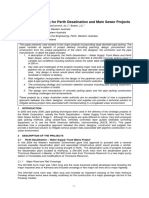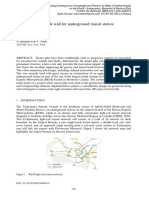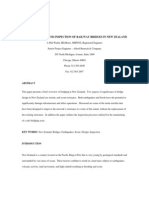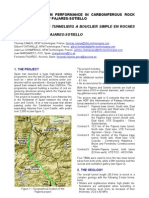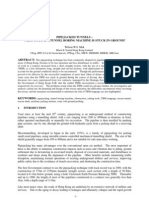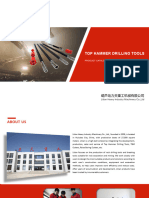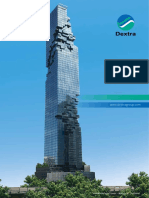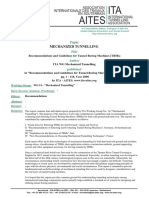Design of Steel Fibre Reinforced Segmental Lining For The Gold Coast Desal Tunnels
Design of Steel Fibre Reinforced Segmental Lining For The Gold Coast Desal Tunnels
Uploaded by
rajesh005Copyright:
Available Formats
Design of Steel Fibre Reinforced Segmental Lining For The Gold Coast Desal Tunnels
Design of Steel Fibre Reinforced Segmental Lining For The Gold Coast Desal Tunnels
Uploaded by
rajesh005Original Title
Copyright
Available Formats
Share this document
Did you find this document useful?
Is this content inappropriate?
Copyright:
Available Formats
Design of Steel Fibre Reinforced Segmental Lining For The Gold Coast Desal Tunnels
Design of Steel Fibre Reinforced Segmental Lining For The Gold Coast Desal Tunnels
Uploaded by
rajesh005Copyright:
Available Formats
HOME
Design of Steel Fibre Reinforced Segmental Lining for the Gold Coast Desalination Tunnels
W Angerer1 and M Chappell2
ABSTRACT
This paper describes the design of the steel fibre reinforced precast concrete (SFRC) segmental lining for the intake and discharge tunnels for the Gold Coast desalination plant in Queensland. In addition, the key design requirements and design methods for the lining of these 2 km long, 2.8 m internal diameter tunnels, including structural, durability and maintenance requirements are discussed. Details of the segment configuration and erection process are presented along with information on the manufacture and trial testing of the concrete for the segments. The paper also gives a brief introduction to steel fibre reinforced concrete behaviour. Construction of the tunnels commenced in April 2007, and the authors believe this is the first application of this technology in Australia.
ALIGNMENT
The alignment of the tunnels (see Figure 1) starts at the desalination plant site adjacent to the Gold Coast Airport. Two shafts, 9.6 m internal diameter, of 70 m (intake) and 65 m (discharge) depth provide the access to the tunnels including the TBM launch chambers. The tunnels have a constantly rising grade of 0.1 per cent. The intake tunnel had to be lowered due to the expected poor rock conditions at the intake riser location. Initially the tunnels have a 15 m spacing, which continuously reduces to one diameter at the crossing of the Gold Coast Highway. After passing underneath Short Street the alignment diverges to the riser locations. The first 900 m are onshore with the remainder under the Pacific Ocean. The minimum curve radius is 400 m and the maximum 500 m. About 75 per cent of the tunnels are driven on a straight alignment.
THE PROJECT BACKGROUND
The Gold Coast desalination plant is to provide additional water to the Gold Coast and South East Queensland and is currently under construction. Located in Tugun, adjacent to the Gold Coast Airport, the 125 mL/day facility is being constructed by the GCD Alliance comprising John Holland contractors, Veolia Water Australia, Sinclair Knight Merz and Cardno. The Alliance will also operate the plant for ten years following commissioning in November 2008. Owned by the Queensland State Government and Gold Coast City Council, the plant will provide an emergency bulk water supply for South East Queensland. The tunnelling and marine riser detailed design was carried out by Halcrow Pacific Pty Ltd. The plant includes two tunnels; the intake tunnel of 2.2 km length and the discharge tunnel of 2.0 km length, which are being constructed with Herrenknecht slurry-shield tunnel-boring machines (TBMs). The internal diameter of the tunnels is 2.8 m and they are lined with steel fibre reinforced segments. Connection to the ocean is achieved via a 2.1 m internal diameter offshore riser for each tunnel. The intake tunnel will draw sea water to the plant, where it will undergo reverse osmosis. The brine, product of this process, is then returned to the ocean via the discharge tunnel and riser. The discharge riser is located approximately 230 m north of the intake riser. The distance between the two, as well as the seabed depth and existing currents is designed to allow for the brine to be dispersed efficiently without affecting the quality of the intake water or the marine environment. The combination of high water pressures, severe exposure conditions, onerous durability requirements and tight construction program was a major challenge to the tunnel design. The SFRC segmental lining solution adopted required both advanced durability modelling and innovative temporary works design to meet the client requirements, which included a demanding erection time. Halcrow was chosen as detailed designer due to their extensive experience in SFRC segmental lining design in the United Kingdom and United States of America.
GEOLOGY
The geology at the location of the plant is dominated by two stratigraphic successions, one from the Paleozoic Age, known as Neranleigh-Fernvale Formation, and the other from the Quaternary Age, which comprises estuarine deposits and marine alluvium. The Neranleigh Fernvale Formation comprises sedimentary rocks that were folded and slightly re-crystallised (or metamorphosed) to form steeply inclined strata of meta-sedimentary rocks. Its main rock types are Argillites and Arenites. Argillites (or phyllites) are hardened and slightly re-crystallised mudstone or shale, dark grey to black in colour, very fine grained with the bedding planes generally visible. Arenites are hardened and slightly re-crystallised greywacke rocks, fine- to coarse-grained sediments of mixed composition (moderately metamorphosed clayey sandstones). In the Quaternary Age these rocks were gradually overlain by estuarine deposits and marine alluvium. These materials, which can reach thicknesses of up to 35 m, derive from several sources, including former offshore river bar deposits, beach sands, windblown dunes also known as dune sands, plus estuarine deposits and marine alluvium with moderately over consolidated partly cemented silts, clays and sands.
OPERATION AND MAINTENANCE REGIME
The maintenance regime requires the intake tunnel to be available for inspections and cleaning. Accordingly the tunnel needs to be sealed at the ocean end and fully dewatered to gain access. At the time of writing this paper the operation and maintenance program has not been finalised but guidelines and limits have been defined. It is expected that access to the tunnel will be needed every five years for inspection and maintenance. There are operational limits on the desalination plant shutdown time and these drive the program and time for the tunnel dewatering. Currently the program provides for a five-day period where the tunnel will be fully dewatered. During this period the tunnel will be fully ventilated to allow entry. These periods have a significant impact on the durability of the tunnel, as installing ventilation will cause drying of the tunnel walls. Consequently, every effort will be made during these periods to prevent the tunnel walls from drying.
1. 2.
Senior Tunnel Engineer, Halcrow Pacific Pty Ltd, Level 22, 68 Pitt Street, Sydney NSW 2000. Email: angererw@halcrow.com General Manager Tunnelling, Halcrow Pacific Pty Ltd, Level 1, 542 Station Street, Box Hill Vic 3128. Email: chappellm@halcrow.com
13th Australian Tunnelling Conference
Melbourne, VIC, 4 - 7 May 2008
463
W ANGERER and M CHAPPELL
FIG 1 - Horizontal alignment.
Consultation is ongoing to undertake these works by alternative means that remove the requirement for the tunnel to be dewatered.
SEGMENTAL LINING Design criteria
The design of the segmental lining for the intake and outlet tunnels had to meet the following criteria: Client contractual requirements:
ability to be erected with a vacuum erector; one-pass lining to reduce the tunnel construction program; minimisation of the number of moulds required to meet the
alignment design of the tunnels; and
to provide a watertight structure during construction. Lining type
To meet the above criteria various types of lining were investigated but eventually a trapezoidal lining was chosen as it was the best suited for this application. Trapezoidal linings have been used for small diameter tunnels since the 1990s and offer particular advantages:
100 year design life, severe exposure condition due to the environment and the
tunnel maintenance requirements, (both internal and external), and
to provide support to the rock loads and hydrostatic pressures to provide a watertight structure during maintenance periods.
Additional requirements specified by the Alliance tunnelling contractor, John Holland Tunnelling:
erection of the lining is much quicker than traditional
rectangular segmental linings;
the trapezoidal lining can accommodate an elastomeric
gasket, which is necessary to meet the external groundwater pressures;
erection times for construction of the lining had to be
minimised;
this type of lining eliminates star joints, which are potential
weak points in the waterproofing system;
the lining had to be capable of withstanding the temporary
loads which are created during the manufacturing, handling, erection of segments and shoving of the TBM;
the lining can be designed and manufactured with a taper to
suit the tunnel alignment;
464
Melbourne, VIC, 4 - 7 May 2008
13th Australian Tunnelling Conference
DESIGN OF STEEL FIBRE REINFORCED SEGMENTAL LINING FOR THE GOLD COAST DESALINATION TUNNELS
the lining can be erected in several orientations to meet the
alignment requirements, ie left- and right-hand curves and straight alignments;
the smooth internal finish is conducive to vacuum erection; can be used with either bar reinforcement or fibre
reinforcement; and
the design of these linings creates high accuracy in the
erection of the lining, thus giving additional margins in meeting the required criteria. The extensive experience Halcrow has in designing and working closely with contractors on projects utilising trapezoidal linings was a significant factor in choosing the lining type outlined above.
Structural design
The structural design of segmental lining distinguishes between the construction loading and loadings for the serviceability such as rock load and water pressure. The construction loads comprise all load situations from the production of the segments until the installation in the tunnel and passing of all TBM trailers and train loads. It includes demoulding, trailer loads, stacking, handling, ram loads and annulus grouting. The construction loads are not combined with the serviceability loads, as the load cases do not occur at the same time. The loading of the rock mass onto the segmental lining is considered using three different approaches: 1. The rock load is determined using a convergenceconfinement approach. A ground reaction curve was established for the dominating rock conditions. The rock mass lining interaction is taken into account by calculating a support characteristic curve of the segmental lining at 1.2 m advance rate. The intersection of the ground reaction curve with the support characteristic curve defines the equilibrium of the rock mass liner system. This reduced in situ stress is then transferred into a closed form solution using the method proposed by Sir Alan Muir-Wood and modified by John Curtis (1976) to determine the maximum bending moments and maximum radial deflections. A further rock load is determined using Terzaghis rock load principles as a possible development of this failure due to the grouting annulus could not be disregarded. This is included in the design as a long geological failure zone was identified during the geotechnical investigations. To represent local failure, a series of wedge load cases developed to provide potential load scenarios, as geotechnical investigation did not provide joint information to determine critical rock wedges intersection of major joint set planes. are the set by
eccentricity of load. The eccentricity of load is then used to calculate resultant bending moments in the concrete section and compare them against the section capacity envelope. This analysis is undertaken for both the maximum axial load condition and the maximum deflection condition as predicted from the Muir-Wood/Curtis analysis. The ultimate limit state load combinations are then assessed against a steel fibre reinforced concrete moment thrust capacity curve derived in accordance with the principles of AS5100 (see Figure 2). The design moment of resistance is calculated in terms of residual tensile strength derived from standard beam tests, using the Japanese beam test value of Re,3, where dosage recommendations are available from steel fibre suppliers. To account for serviceability limit state, a calculation of the maximum tensile stresses in the concrete section for the SLS load combinations is carried out. Generally, it is impossible to reliably predict crack width in SFRC structures without conventional reinforcement since the crack widths are not related to stresses given by elastic analysis once the section capacity is exceeded and softening develops. In spite of this, crack width can be estimated using the method given in the RILEM - design guideline (2000). The results of the maximum serviceability stress analysis reveal a realistic flexural first crack strength limit in comparison to the ultimate limit state residual stresses. The first crack strength is therefore defined to keep the segments within its elastic boundaries and to avoid occurrence of cracking. This approach is also consistent with the durability requirement to not allow cracks bigger than 0.1 mm.
STEEL FIBRE REINFORCED CONCRETE
Concrete is a brittle material with a low tensile strength. Adding steel fibres to concrete enhances its toughness, ductility and energy absorption capacity under impact. Steel fibres can reduce the formation and development of cracks due to early-age plastic settlement and drying shrinkage. They also provide a degree of post-cracking load-carrying capacity. Tunnel linings (non-segmental) have been unreinforced as an industry standard on many projects, as a well-designed tunnel profile predominantly acts in compression. Reinforcement in nearly perfectly circular TBM tunnels is mainly required to achieve capacity for construction loading. Steel fibres add considerable strength to concrete against bursting and spalling, which are the main concrete failure mechanisms that occur during TBM tunnel construction. The simplified manufacturing process also leads to a potential cost saving in comparison to conventionally reinforced segments. SFRC is also considered to be at least as durable as normal concrete but in general to be superior. These advantages have to be balanced against the necessity for advanced concrete technology, increased testing requirements and a potential for surface discoloration.
2.
3.
The rock loading is analysed in combination with the hydrostatic loads. The above methods do not explicitly take into account ring build shape tolerances and other potential deformations. In order to account for these deformations an analysis of the concrete section is undertaken by assuming that the segment acts as short columns. For this analysis, the axial loads and deflection results are taken from the rock load calculation and the additional imposed deflections are added to these results. The new total ring deformation is then applied to the circular lining, assuming the lining deforms into an approximate ellipse. Following this geometric deformation, it is assumed that the segment body is stiff compared to the joint, and all deformation occurs at the joints. Angular rotations are calculated and the axial loads are then applied. The elastic deformation of the concrete is calculated to give a resultant bearing area, stress distribution and
Behaviour of steel fibre reinforced concrete (Technical Report No 63, 2007)
The residual flexural strength after cracking depends on the fibre type and dosage. The type of load deflection response shown in Figure 3 is known as strain softening since flexural resistance reduces with increased deformation after cracking. This behaviour type differs from that of reinforced concrete where the flexural resistance increases after cracking, provided that the minimum amount of reinforcement specified in structural design codes is provided. The effect of the reduction in flexural capacity of SFRC after cracking can be seen by considering the behaviour of a simply supported beam loaded at its third points. The beam cracks at the weakest section within its central third where the moment is
13th Australian Tunnelling Conference
Melbourne, VIC, 4 - 7 May 2008
465
W ANGERER and M CHAPPELL
FIG 2 - Moment thrust curve.
FIG 3 - Characteristic load-deflection diagram for ASTM 1609 beam test.
uniform. Subsequently, the load reduces as in Figure 3, if the loading is displacement controlled and no further cracks form. This response is similar to the response of concrete with less reinforcement than the minimum prescribed by design codes. No significant difference in behaviour would be noted in a load-controlled test between a plain concrete and a SFRC simply supported beam. The tensile capacity of the concrete is the main factor for the beam behaviour up to the first peak crack. The benefit of steel fibres arises solely from the ductility they add after cracking. The steel fibres therefore have a major impact on the brittleness of a failure.
Performance specification
The best available guidance for the performance of SFRC is supplied by fibre manufacturers in the form of published data
sheets, but these cannot be expected to be specific to each individual concrete mix. Testing of the SFRC is required to confirm that the design parameters are met and also allows for optimisation of the fibre content during production. Design by performance testing, or proof testing, is an approved method contained in all structural codes. It is applicable to repetitive units, where a large number of items are required for a particular purpose and therefore fit for the purpose of segment manufacture. The target fibre content is determined on the basis of experience and suppliers guidelines. Representative completed units are then tested during trial testing to demonstrate the ability to achieve the specified flexural and tensile strength of the concrete. The production fibre content should be chosen with care, to avoid considerable changes in quantities, which would lead to the necessity of re-approval of the mix with all the
466
Melbourne, VIC, 4 - 7 May 2008
13th Australian Tunnelling Conference
DESIGN OF STEEL FIBRE REINFORCED SEGMENTAL LINING FOR THE GOLD COAST DESALINATION TUNNELS
specified testing. Changes of 5 kg or less are considered to not have sufficient impact on the concrete mix to warrant re-testing and re-approval. The flexural strength test on this project is defined as the ASTM C1609 beam test. First crack strength is defined as 4.6 MPa and a residual flexural strength of 3.2 MPa is required. In addition, the tensile strength is defined as 4.2 MPa. The design parameters were achieved by using 35 kg/m3 of Dramix 80/60 fibres with a concrete mix using 480 kg/m3 cementitious material. Silica fume, fly ash and Portland Cement are required as cementitious materials in the specification.
production or transportation would lead to rejection of the segment. Cracks occurring after ring build are repaired with materials that provide similar durability resistance to the segment concrete. Furthermore, in order to assess the potential of hammer drilling to induce cracks bigger than the recommended 0.1 mm, drill tests were carried out. The specimens were petrographically examined for cracks and the results allowed hammer drilling of up to 16 mm drill size to be approved.
Durability modelling
From a corrosion propagation point of view, SFRC is at least as durable as normal reinforced concrete and unlike conventional concrete, spalling due to reinforcement corrosion is considered unlikely. However, it is prudent to make provision for possible corrosion of the fibres in the long term. The durability modelling must consider the boundaries derived from the maintenance regime and the construction program. Deterministic modelling of carbonation and chloride ingress by diffusion and under a pressure head was undertaken, and the effect of the different conditions upon corrosion of the fibres was assessed. As the tunnel will be full of water in service, carbonation is considered to be largely confined to the construction period. Corrosion should be very slow due to the low availability of oxygen to the intrados during operation and the extrados during construction and operation. This was accounted for in the carbonation modelling. Chloride modelling is based on a diffusion coefficient acknowledging an ageing effect. The different levels of chloride exposure in the intake and discharge tunnels are taken into account. Temperature effects during the service life were considered. It should be pointed out that outages are extremely important, as these will permit much higher rates of corrosion due to the higher availability of oxygen in concrete containing levels of chloride above the corrosion threshold. Corrosion can be controlled by specifying a minimum frequency and duration of those maintenance periods. Outages at a later time during the structure life have a higher impact on corrosion than outages at a young age. Based on this modelling, a loss of fibres of 25 mm on the intrados and 15 mm on the extrados is considered for design. This reduces the lining thickness considerably in comparison to the 40 to 50 mm to each exposed face as industry standard without advanced durability modelling. The oxygen diffusion coefficient and the chloride diffusion coefficient are main features of the concrete specifications to allow for this thickness reduction.
Durability
The minimum design life for the permanent tunnelling and marine riser structures is 100 years. There is limited information available on the long-term durability of SFRC due to its lesser incidence of use and the time over which it has been used. The limited availability of data has tended to confine the application of SFRC to less adverse environmental conditions outside the tunnelling industry. However, there is considerable evidence of satisfactory, durable performance of SFRC from short to medium term and accelerated testing. A general review of the properties of SFRC relative to conventionally reinforced concrete is given in Table 1. TABLE 1
Summary of properties of steel fibre reinforced concrete.
Issue Abrasion Carbonation Chloride ingress Corrosion Cracking Handling damage Impact Shrinkage Steel fibre reinforced concrete compared to reinforced concrete Improved due to reduced bleeding Fibres in the immediate surface layer corrode Reduction of chloride levels at surface No galvanic corrosion or spalling Corrosion of fibres for width >0.1 mm Improved Improved due to control of crack propagation Cracking reduced
For a long-term view for use in tunnels, it is appropriate to extrapolate performance from its use in aggressive conditions such as marine environments.
Crack control
Where cracking intercepts fibres then some corrosion of the fibres is expected. Reviews by others of a number of durability studies concluded that steel fibre reinforced concrete will be as durable as conventionally reinforced concrete and that a restriction in crack widths to that normally specified for conventional reinforced concrete will lead to a satisfactory design with much of the flexural strength retained. However, field exposure of cracked specimens reinforced with steel fibre has identified corrosion and performance loss with cracks greater than 0.1 mm width leading to significant rates of corrosion. Previous experience suggests that crack widths over 0.2 mm should be avoided, and show that the depth of the crack has a considerable impact. In view of the long design life and severe service conditions it is recommended for this project that crack width should be restricted to 0.1 mm. The SLS design aims to provide a first crack limit above the design scenarios, and that cracks occurring during segment
Testing regime as per specification
The testing regime is divided into three phases to allow for smooth production with a minimum of non-conformances. These phases are:
laboratory trial testing, production trial testing, and production testing.
The concrete mix is to be developed during the laboratory trial testing. The influence of the mix plant and the production environment on the mix is then to be assessed during the production trial testing. The performance during segment manufacture is then determined with the production testing. A combination of rapid testing together with long duration testing for durability testing is specified to ensure no hold up of
13th Australian Tunnelling Conference
Melbourne, VIC, 4 - 7 May 2008
467
W ANGERER and M CHAPPELL
the production due to absence of test data. Overall, it is considered that at least three months are required to establish a mix design that allows for efficient production. As problems with concrete mixes generally arise from the choice of aggregate, a comprehensive pre-approval program for the fine and coarse aggregates is established. The program is based upon the AS2758.1 requirements. The coarse aggregate is defined to be basalt. The main hardened concrete tests are summarised in Table 2. TABLE 2
Hardened concrete testing as per specification.
Test Drying shrinkage Flexural testing Tensile splitting strength Compressive strength Long-term strength gain Chlorides and chloride penetration Oxygen diffusion test Standard AS1012.13 ASTM1609 AS1012.10 AS1012.9 AS1012 AS1012, AASHTO T277-83, AASHTO T259 (replaced with NTB 492) Test procedure as defined in specification
SEGMENTAL LINING LAYOUT
Following the deliberations which ensued from the initial decision to adopt a segmental lining, of which only part is described in this paper, the following precast segmental lining was adopted. The tunnel lining arrangement for this project is a six plate trapezoidal segment configuration, which is manufactured as a uniformly tapered ring. The trapezoidal layout (see Figure 4) avoids cruciform joints with many combinations of ring rotations and allows building all rings from the invert upwards at any time, thus providing good leakage control and ring build safety. A drawback is that a relatively long ram stroke is required to push the final key segment into position. However, the advances on the tailskin articulation joints of TBMs permit the lining to be built without hindrance. The internal diameter is 2800 mm and the ring length is 1200 mm. A taper allows a theoretical minimum bend radius of 275 m, with the alignment having a minimum radius of 400 m. The alignment is designed with transition curves, which is not general practice in water tunnels. However, it eases the navigation of the 3.44 m diameter TBM with a 12 m long shield.
The lining is equipped with a gasket groove for an elastomeric gasket towards the extrados of the joint contact area. The rings are designed for the use of Phoenix gasket profile M 385 41a. The working pressure is defined as seven bar. Two different gasket grooves are provided on the radial circumferential joints due to the gasket pressure limitation. The use of a packer on the circumferential joint influences the gap parameter, which is counterbalanced by an adapted groove depth. The lining joint detail is further equipped with a caulking groove on the intrados. The caulking groove and gasket groove are designed to provide a symmetric contact area at the joints. This reduces the bearing and bursting stresses at the joint and centralises the line of thrust. Twelve circumferential dowels are arranged in six pairs spaced on a 30 degree angle around the centre to provide the drifting system for the ring build. The dowels are arranged to suit the TBM rams. They have been designed to provide tensile resistance to the potential opening pressures imposed by gasket compression as well as shear resistance for installed segments with no ram load applied and prior to the ring being completed. The high groundwater pressures of up to seven bar necessitate high gasket compression. This leads to restrictions in the choice of the drifting system, as the compressive forces lead to considerable pull-out resistance being required on the circumferential dowels. The Sofrasar Sof-fix system provides this capacity but is geometrically more suited to a rectangular ring layout. The length of the dowels leads to restrictions on the ring build. To minimise this effect, a number of circumferential dowels were shortened in length. Although this locally reduces the pull-out capacity, the compression forces are distributed over all 12 dowels to achieve the necessary capacity. No increased circumferential joint openings at the location of the shortened dowels have been registered during construction to date. Primary grouting of the segments is carried out through the grout socket in the segments. The grout socket is also designed to act as a shear cone for the vacuum erector, together with a second recess provided symmetrically around the centre of gravity of the segment. The grout sockets are carried out without concrete cover on the extrados to reduce grouting drill times and potential cracking of the SFRC concrete during the drilling works. The grout system type ZU by Sofrasar was applied with a non-return valve on the extrados and a grout plug with O-ring seal on the intrados. The choice of ring layout is confirmed during construction with ring build times of constantly below 15 min being achieved.
FIG 4 - Developed elevation of ring on intrados.
468
Melbourne, VIC, 4 - 7 May 2008
13th Australian Tunnelling Conference
DESIGN OF STEEL FIBRE REINFORCED SEGMENTAL LINING FOR THE GOLD COAST DESALINATION TUNNELS
LESSONS LEARNED Flexural testing
Technical Report No 63 (2007), Chapter 6, compares two uniformly loaded geometrically identical concrete beams, one made from SFRC and the other from plain concrete, to determine basic design criteria for SFRC concrete. It concludes that the strength and ductility of a beam, in comparison to plain concrete, is only predicted to increase if Re,3 is greater than 0.5. Re,3 is defined as the equivalent flexural ratio as per Japanese Concrete Institute standard test JCI-SF4. The design addresses this issue by defining a maximum cement content in order to avoid concrete compressive and tensile strength from becoming too high and to achieve the required ductility of the segments. The segment manufacturer utilised the maximum cement content on the project. After months of initial compressive strength test results of around 60 MPa after 28 days, an increase in results with production time was noted due to several factors, but mainly due to a change in outside temperature. As a result, the flexural test results increased compared to the first crack strength, but stayed constantly low, but above the design value for the residual flexural strength. This experience showed that care should be taken when choosing the cement content of the concrete mix for SFRC concrete, as too much cement can be counterproductive. An alternative for better production control would be to consider a definition and monitoring of first crack strength and Re,3. This defines the ratio between first crack and residual strength, which directly relates to brittleness of the concrete mix which controls the failure of the segments. A control of the concrete mix by these values reflects the SFRC properties in a better way for interpretation and development of production trends.
The testing for this project was finally carried out in Queensland, New South Wales, Victoria and Western Australia in order to provide all the testing required. The contractor was faced with a major challenge in finding laboratories that had the capacity and know-how to carry out testing with the frequencies and limits as required. Also, the test results are required to be fed back into the production as soon as possible to reduce the risk of non-conformances and provide the feedback required for the manufacture of the segments. These market restraints were not known of prior to the project and this restraint needs to be taken on board for any potential future application of a similar design. Also, it has been suggested at recent Concrete Technology Conferences (eg Merretz, Smith and Borgert, n/d) that designers are over-designing the testing regime for concrete similar to that used on this project and that testing should be based on compressive strength testing only. It is true that correlations between the compressive strength with the majority of hardened concrete properties exist. The authors believe these correlations are not adequately reliable to satisfy current client durability requirements. Also optimisations in lining thicknesses, such as were achieved with the application of chloride and carbonation modelling cannot be validated in this way.
ACKNOWLEDGEMENTS
Halcrow would like to take this opportunity to thank the Gold Coast Alliance, and in particular the John Holland Marine and Tunnelling Team led by Tony Bermingham, for the very productive and open-minded working environment. During this project, the team has focused on delivering safe, technically sound and innovative engineering solutions to ensure that the final product achieved the client requirements in a high performance construction environment. We believe that meeting and surpassing all the major milestones of the project so far is a result of this successful teamwork. The authors wish also to thank their colleagues Don Wimpenny (Durability Consultant), Christian Goritschnig (Geologist) and James Garnier (Project Manager), all part of the Halcrow Gold Coast design and site team, for their support in producing this paper.
Chloride diffusion testing
AASTHO T277-83 rapid chloride penetration in conjunction with an AASTHO T259 immersion test was chosen to determine the chloride penetration of the concrete. The rapid test was intended to be used for mix design development and the immersion test to confirm that the durability model parameters are satisfied. The tight production program did not allow for the immersion test to be carried out before production was started. In addition, the results of the rapid test showed too much variation to allow any firm opinion to be formed on the chloride penetration characteristics of the concrete mix. The AASTHO tests were replaced with the Nordtest method Built 492 test, which is more reliable and is directly related to the chloride diffusion coefficient of the durability model. It should also be noted that the chloride diffusion coefficient is time-dependent. As this dependency was a major consideration in the durability model, the specified test result of 28 days was required. The laboratories involved frequently undertook these tests at different time intervals and did not indicate this in the test certificate initially, which led to misinterpretations.
REFERENCES
Austrian Society for Concrete and Construction Technology (Oesterreichischen Vereinigung fuer Beton und Bautechnik), 2002. March, Richtlinie Faserbeton. British Tunnelling Society and the Institution of Civil Engineers, 2000. Specification for tunnelling. Carranza-Torres, C and Fairhurst, C, 2000. Application of the convergence-confinement method of tunnel design to rock masses that satisfy the Hoek-Brown failure criterion, Tunnelling and Underground Space Technology, 15(2):187-213. Curtis, D J and Muir Wood, A M, 1976. Discussion on: The circular tunnel in elastic ground, Geotechnique, 26:231-237. DBV-Recommendation (German Concrete Association), 1992. Design principles of steel fibre reinforced concrete for tunnelling works, pp 19-29, September. Translation of: DVB Merkblaetter Faserbeton Technologie des Stahlfaserbetons und Stahlfaserspritzbetons Bemessungsgrundlagen fuer Stahlfaserbeton im Tunnelbau. Fournier, B, 2002. The role of fly ash in controlling alkali-silica reaction in concrete, presented to Seventh International Conference on Gypsum and Fly Ash, Toronto, June. Granju, J L and Balouch, S U, 2005. Corrosion of steel fibre reinforced concrete from the cracks, Cement and Concrete Research, 35:572-577. King, M R and Alder, A J, 2001. The practical specification of steel fibre reinforced concrete (SFRC) for tunnel linings, presented to Underground Construction Conference, London.
Laboratory capacities in Australia
Production of segmental linings, such as those chosen for the Gold Coast desalination tunnels, places considerable reliance on concrete testing. SFRC has a different behaviour compared to conventional reinforced concrete, which requires designs to be verified by performance testing. This, together with onerous client durability requirements, leads to a considerable amount of testing being required before and during production.
13th Australian Tunnelling Conference
Melbourne, VIC, 4 - 7 May 2008
469
W ANGERER and M CHAPPELL
Komiya, K, Soga, K, Akagi, H, Hagiware, T and Bolton, M D, 1999. Finite element modelling of excavation and advancement processes of a shield tunnelling machine, Soils and Foundations (Japanese Geotechnical Society), 39(3):37-52. Kramer, G J E, Gregor, T, Ghazi, M and Herbert, C D, 2003. Segment design for tunnelling productivity, in RETC Proceedings, Chapter 62, pp 697-710. Mangat, P S, Molloy, B T and Gurusamy, K, n/d. Marine durability of steel fibre reinforced concrete of high water/cement ratio, University of Aberdeen, Taywood Ltd. Merretz, W, Smith, G and Borgert, J, n/d. Chloride diffusion in concrete specification A contractual minefield, Structural Concrete Industries (Aust) Pty Ltd.
Moens, J, 1990. State-of-the-art report on the durability of FRC, November, N V Bekaert Zwevegem. Rilem, T C, 2000. RILEM TC 162-TDF: Test and design methods for steel fibre reinforced concrete Recommendations, Materials and Structures/Materiaux et Constructions, 33:75-81. The Concrete Society, 1993. Technical report No 41, Microsilica in concrete, UK. The Concrete Society, 2003. Technical report No 34, Concrete industrial ground floors A guide to their design and construction, UK. The Concrete Society, 2007. Technical report No 63, Guidance for the design of steel-fibre-reinforced concrete, UK.
470
Melbourne, VIC, 4 - 7 May 2008
13th Australian Tunnelling Conference
You might also like
- Design Standards Volume 3 06 DrainageDocument146 pagesDesign Standards Volume 3 06 DrainageLeonardo TejedorNo ratings yet
- ST THDocument121 pagesST THfidicNo ratings yet
- Technical Proposal: Genale Dawa-6 Hydroelectric Power ProjectDocument486 pagesTechnical Proposal: Genale Dawa-6 Hydroelectric Power ProjectEyob Ad100% (1)
- Presentation - Tunel de ClaytonDocument7 pagesPresentation - Tunel de ClaytonMichael HurtadoNo ratings yet
- Characteristics of A Large-Scale Deep Foundation Pit Excavated by The Central-Island Technique in Shanghai Soft Clay. I - Bottom-Up Construction of The Central Cylindrical Shaft - ImportanDocument19 pagesCharacteristics of A Large-Scale Deep Foundation Pit Excavated by The Central-Island Technique in Shanghai Soft Clay. I - Bottom-Up Construction of The Central Cylindrical Shaft - ImportanIsaac Liu100% (1)
- Duddeck ErdmannDocument1 pageDuddeck ErdmannLuis ZhanNo ratings yet
- Design Segmental Precast Linning Tunnel LiningDocument29 pagesDesign Segmental Precast Linning Tunnel LiningMirna KristiyantoNo ratings yet
- 2019.0096-0400-R-011-R0-A - Segmental Lining ConceptDocument36 pages2019.0096-0400-R-011-R0-A - Segmental Lining Concepthaureta_novaNo ratings yet
- 100-Year Design Life of Rock Bolts and Shotcrete - 5th Ground Support in Mining Underg ConstDocument6 pages100-Year Design Life of Rock Bolts and Shotcrete - 5th Ground Support in Mining Underg Consteep1977No ratings yet
- Shotcrete Lining For Irrigation Canal LiningDocument6 pagesShotcrete Lining For Irrigation Canal LiningYosvany100% (1)
- Revised Ahmedabad Metro DPR Compiled 20th May 2015 PDFDocument666 pagesRevised Ahmedabad Metro DPR Compiled 20th May 2015 PDFSOMU_61No ratings yet
- Construction of Large Span Shallow Tunnels: A Case Study From The New M5 - PublishedDocument6 pagesConstruction of Large Span Shallow Tunnels: A Case Study From The New M5 - Publisheddafo407No ratings yet
- TBM Crossing StationsDocument21 pagesTBM Crossing StationsDEBASIS BARMANNo ratings yet
- Bored TunnelDocument7 pagesBored TunnelMohafisto SofistoNo ratings yet
- Nasri Final Tunnel Linings PDFDocument74 pagesNasri Final Tunnel Linings PDFlalita mahaleNo ratings yet
- 62 Determination Load Sharing Effects Sprayed Concrete Tunnel LiningsDocument8 pages62 Determination Load Sharing Effects Sprayed Concrete Tunnel Liningsp_ignatiusNo ratings yet
- Tunnel Segmental Lining Durability (Fastening)Document10 pagesTunnel Segmental Lining Durability (Fastening)Cristián GonzálezNo ratings yet
- Using Fracture Grouting To Lift Structures in Clayey SandDocument8 pagesUsing Fracture Grouting To Lift Structures in Clayey SandxheurtauxNo ratings yet
- Code of Practice For Reinforcement of Rock Slopes With Plane Wedge FailureDocument16 pagesCode of Practice For Reinforcement of Rock Slopes With Plane Wedge FailurePabloNo ratings yet
- Influence of Deep Excavations On Nearby Existing TunnelsDocument11 pagesInfluence of Deep Excavations On Nearby Existing Tunnelskrainajacka100% (1)
- Analysis of The Stand UpDocument6 pagesAnalysis of The Stand UpSafar Al InseNo ratings yet
- FRC TunnelDocument10 pagesFRC TunnelrameshkaaNo ratings yet
- Design and Construction of Large Span Tunnels and Caverns in Sydney, AustraliaDocument9 pagesDesign and Construction of Large Span Tunnels and Caverns in Sydney, Australiadafo407No ratings yet
- Soft Ground Tunneling For MRT in Urban AreasDocument15 pagesSoft Ground Tunneling For MRT in Urban AreasniceAIT0% (1)
- UCASE Incremental DesignDocument76 pagesUCASE Incremental DesignctrleNo ratings yet
- Large Diameter Pipe Roof Box Excavation For Passenger Linkway TunnelDocument14 pagesLarge Diameter Pipe Roof Box Excavation For Passenger Linkway TunnelMH Enc Const TrdNo ratings yet
- Compensation GroutingDocument37 pagesCompensation GroutingPablo RincónNo ratings yet
- Design and Construction of A Segmental LiningDocument9 pagesDesign and Construction of A Segmental LiningLiew Yen Ching100% (1)
- Innovation in Bored Tunnel Segmental Lining Design in Singapore - Steel Fiber Reinforced Concrete (SFRC)Document9 pagesInnovation in Bored Tunnel Segmental Lining Design in Singapore - Steel Fiber Reinforced Concrete (SFRC)SeasonNo ratings yet
- Charact of Phyllites For TunnellingDocument6 pagesCharact of Phyllites For TunnellingNadim527No ratings yet
- Design Considerations For Bored Tunnels at Close ProximityDocument8 pagesDesign Considerations For Bored Tunnels at Close ProximityMehdi BakhshiNo ratings yet
- Rock Fissure Grouting in Singapore GraniteDocument6 pagesRock Fissure Grouting in Singapore GraniteShumei ZhouNo ratings yet
- Bored Tunnels in Soft SoilsDocument7 pagesBored Tunnels in Soft SoilsDEBASISNo ratings yet
- Ismailia Road Tunnel Crossing The Suez Canal PDFDocument8 pagesIsmailia Road Tunnel Crossing The Suez Canal PDFRonald HeijmansNo ratings yet
- Challenging Features in Design and Execution of A Low Overburden Underpass - A Case History From Malaysia: PLUS North-South HighwayDocument10 pagesChallenging Features in Design and Execution of A Low Overburden Underpass - A Case History From Malaysia: PLUS North-South HighwayYap Wen KhongNo ratings yet
- Ground Treatment For TunnellingDocument22 pagesGround Treatment For Tunnellingthauwui860% (1)
- E Ect of Building Sti Ness On Tunnelling-Induced Ground Movement-MAIRDocument13 pagesE Ect of Building Sti Ness On Tunnelling-Induced Ground Movement-MAIRSérgio BernardesNo ratings yet
- 200 Limestones of Jurong Formation Engineering ExperienceDocument9 pages200 Limestones of Jurong Formation Engineering ExperiencegahsoonNo ratings yet
- Ground Improvement For Bored Tunnel in Reclaimed LandDocument10 pagesGround Improvement For Bored Tunnel in Reclaimed LandSeng SiongNo ratings yet
- Specifications Segment Inserts & GasketsDocument6 pagesSpecifications Segment Inserts & Gasketssatan007No ratings yet
- Atk Microtunnelling Presentation R1Document29 pagesAtk Microtunnelling Presentation R1Gaurav MathurNo ratings yet
- MacroSyntheticFiberReinforced TunnelLinings PDFDocument13 pagesMacroSyntheticFiberReinforced TunnelLinings PDFDaniel ZabalaNo ratings yet
- The Prediction of Volume LossDocument4 pagesThe Prediction of Volume LossTestNo ratings yet
- Technical Paper On DesignDocument8 pagesTechnical Paper On DesignTunnel BhauNo ratings yet
- Design and Construction of Deep ShaftDocument14 pagesDesign and Construction of Deep Shaftkiwanis_lam50% (2)
- Water Control in Norwegian Tunnelling: E. GrøvDocument10 pagesWater Control in Norwegian Tunnelling: E. GrøvHarold TaylorNo ratings yet
- 2 ITATech Sprayed Membranes CelestinoDocument60 pages2 ITATech Sprayed Membranes CelestinoMarcelo ApoloNo ratings yet
- Tunnel Lining Brief DesignDocument16 pagesTunnel Lining Brief DesignParmeshwar KushwahaNo ratings yet
- The Choice of EPB or Slurry Shields For Tunnelling in Mixed Face Conditions Resulting From Tropical WeatheringDocument17 pagesThe Choice of EPB or Slurry Shields For Tunnelling in Mixed Face Conditions Resulting From Tropical WeatheringfreezefreezeNo ratings yet
- Foundations For The Future - Removal of Existing PilesDocument8 pagesFoundations For The Future - Removal of Existing PilesskkongNo ratings yet
- Heinke Tunnel Segment GasketsDocument6 pagesHeinke Tunnel Segment GasketsChin Thau WuiNo ratings yet
- Mna-034 CT 07 ADocument19 pagesMna-034 CT 07 ASenthil NathNo ratings yet
- Tunnelling Induced Ground Movements and Their EffectsDocument62 pagesTunnelling Induced Ground Movements and Their Effectskksamy2007No ratings yet
- Elasto-Plastic Solution of A Circular TunnelpdfDocument16 pagesElasto-Plastic Solution of A Circular TunnelpdfssheafiNo ratings yet
- Son 2005Document16 pagesSon 2005jose monteNo ratings yet
- 2015 - Segmental Linings A Vision For The FutureDocument15 pages2015 - Segmental Linings A Vision For The FutureJoeNo ratings yet
- Soft Ground NATM - David LeesDocument9 pagesSoft Ground NATM - David Leesmilan_popovic_2No ratings yet
- Pipa JackingDocument8 pagesPipa Jackingfikri ramadhanuNo ratings yet
- Deep Shaft Design and ConstructionDocument14 pagesDeep Shaft Design and ConstructionFabio Nascimento100% (3)
- Diaphragm Wall Quays For Myanmar Mega-PortDocument3 pagesDiaphragm Wall Quays For Myanmar Mega-PortrakhbirNo ratings yet
- Permanent Secant Pile Wall For Underground TransitDocument9 pagesPermanent Secant Pile Wall For Underground Transitshiralrohan10No ratings yet
- Shotcrete Use in The Southern Link Tunnel, Stockholm: Swedish National Road AdministrationDocument6 pagesShotcrete Use in The Southern Link Tunnel, Stockholm: Swedish National Road AdministrationHarold TaylorNo ratings yet
- Design, Retrofit and Inspection of Railway Bridges in New ZealandDocument23 pagesDesign, Retrofit and Inspection of Railway Bridges in New Zealandatac101No ratings yet
- Maintenance of PSC GirdersDocument10 pagesMaintenance of PSC GirdersradhakrishnangNo ratings yet
- Design Flood EstimationDocument18 pagesDesign Flood Estimationrajesh005No ratings yet
- Numerical Modelling and HydraulicsDocument158 pagesNumerical Modelling and Hydraulicsrajesh005100% (1)
- Notes To Users: This Document Is A Template. The Template Was Created by Generalizing The BridgeDocument15 pagesNotes To Users: This Document Is A Template. The Template Was Created by Generalizing The Bridgerajesh005No ratings yet
- Guidelines River Morphological Reports March09Document29 pagesGuidelines River Morphological Reports March09Harish Kumar MahavarNo ratings yet
- Edepotlink I71119 001-Here!Document58 pagesEdepotlink I71119 001-Here!Shem BarroNo ratings yet
- Problem Statement: One River Reach (River TREEO, Reach Main) DischargesDocument10 pagesProblem Statement: One River Reach (River TREEO, Reach Main) Dischargesrajesh005No ratings yet
- 16.2 Derivation of Uniform Flow Equations: 1 1 Wsinθ 2 2Document3 pages16.2 Derivation of Uniform Flow Equations: 1 1 Wsinθ 2 2rajesh005No ratings yet
- HREPRTDocument10 pagesHREPRTrajesh005No ratings yet
- Current U.S. Army Corps of Engineers' Policy and Guidance For Seismic Design of Dams-Anjana Chudgar and Enrique E. MatheuDocument9 pagesCurrent U.S. Army Corps of Engineers' Policy and Guidance For Seismic Design of Dams-Anjana Chudgar and Enrique E. Matheurajesh005No ratings yet
- 38.1 Surge Computation: Surges - Moving (Travelling Fronts)Document5 pages38.1 Surge Computation: Surges - Moving (Travelling Fronts)rajesh005No ratings yet
- Chapter 10Document79 pagesChapter 10oockla1031No ratings yet
- Double-Mass Curve USGSDocument41 pagesDouble-Mass Curve USGSrajesh005100% (1)
- In Situ Stress Measurement - HimalayasDocument6 pagesIn Situ Stress Measurement - Himalayasrajesh005100% (1)
- Tunnel FailureDocument237 pagesTunnel FailureAlexandra Moldovan100% (5)
- Elkadi2002 IntersectionDocument7 pagesElkadi2002 Intersectionroumaissa haddadNo ratings yet
- TBM Carboniferous Rock PajaresDocument7 pagesTBM Carboniferous Rock PajaresThomasCamusNo ratings yet
- Under Ground Power House: Location of Underground Power StationsDocument34 pagesUnder Ground Power House: Location of Underground Power StationsWonda TayeNo ratings yet
- Pressure Gradients at The Tunnel Face of An EPB ShieldDocument6 pagesPressure Gradients at The Tunnel Face of An EPB ShieldBob MoncrieffNo ratings yet
- The Performance Prediction of A TBM in Difficult GroundDocument12 pagesThe Performance Prediction of A TBM in Difficult GroundskenNo ratings yet
- Fhwa If 05 023 (Tunnels Design Guidelines)Document148 pagesFhwa If 05 023 (Tunnels Design Guidelines)Jorge Robles50% (2)
- Barton, N. 2022Document26 pagesBarton, N. 2022Ale LeNo ratings yet
- WTC 2020 - Full Paper 1 (ACI 533) - 402 - FinalDocument6 pagesWTC 2020 - Full Paper 1 (ACI 533) - 402 - FinalMehdi BakhshiNo ratings yet
- Shield TBM - Advanced Tunneling MethodDocument14 pagesShield TBM - Advanced Tunneling MethoddilaksanNo ratings yet
- 9 TBM Boreability I Hard BergmasseDocument43 pages9 TBM Boreability I Hard BergmassepabulumzengNo ratings yet
- Pipe JackingDocument0 pagesPipe JackingJc Aviles MartinezNo ratings yet
- 2006 02 01 - LettoDocument44 pages2006 02 01 - LettogifantaNo ratings yet
- Pipe Jacked TunnelsDocument10 pagesPipe Jacked Tunnelsretk0801No ratings yet
- Top Hammer Tools Brochure-LitianDocument54 pagesTop Hammer Tools Brochure-Litianvukqwerty1112321321No ratings yet
- Construction Methods For TunnelDocument11 pagesConstruction Methods For Tunnelsaihung123No ratings yet
- DEXTRA GROUP Brochure V2020onlineDocument28 pagesDEXTRA GROUP Brochure V2020onlineKevin ArNo ratings yet
- Specifications Segment Inserts & GasketsDocument6 pagesSpecifications Segment Inserts & Gasketssatan007No ratings yet
- TJ Oct-Nov'17Document82 pagesTJ Oct-Nov'17DEBASISNo ratings yet
- The Almabani Journal E-Edition No 12Document32 pagesThe Almabani Journal E-Edition No 12sajid.abdullahNo ratings yet
- Mechanised Tunnelling Recommendations - ITA - TBMDocument119 pagesMechanised Tunnelling Recommendations - ITA - TBMBob MoncrieffNo ratings yet
- History of Tunneling in Norway PDFDocument84 pagesHistory of Tunneling in Norway PDFWill WonkaNo ratings yet
- TERRATEC General BrochureDocument9 pagesTERRATEC General Brochuree155159No ratings yet
- Uttarkashi Tunnel Collapse PresentationDocument8 pagesUttarkashi Tunnel Collapse PresentationYaser SaeedNo ratings yet
- Elwynh 140110085343 Phpapp01Document558 pagesElwynh 140110085343 Phpapp01sophe87100% (2)
- DAUB 2021-03 Recommendations For The Selection of Tunnel Boring MachinesDocument55 pagesDAUB 2021-03 Recommendations For The Selection of Tunnel Boring MachinesGeopatarecaNo ratings yet











